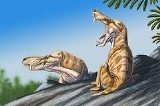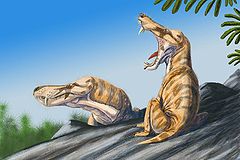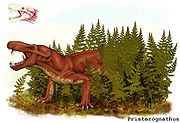
Pristerognathus
Encyclopedia
Pristerognathus is an extinct genus
of therocephalian, known from the late Middle Permian
(Capitanian
) of South Africa
. It lends its name to the Pristerognathus Assemblage Zone
of the Beaufort Group
of South African geological strata.

 These animals were roughly cat-sized, and are characterized by long, narrow skulls with large canines. They are likely to have preyed on smaller therapsids and millerettids of the time.
These animals were roughly cat-sized, and are characterized by long, narrow skulls with large canines. They are likely to have preyed on smaller therapsids and millerettids of the time.
Pristerognathus was discovered in 1904 by Broom. Three species are known: P. baini, P. polyodon, and P. platyrhinus.
Genus
In biology, a genus is a low-level taxonomic rank used in the biological classification of living and fossil organisms, which is an example of definition by genus and differentia...
of therocephalian, known from the late Middle Permian
Permian
The PermianThe term "Permian" was introduced into geology in 1841 by Sir Sir R. I. Murchison, president of the Geological Society of London, who identified typical strata in extensive Russian explorations undertaken with Edouard de Verneuil; Murchison asserted in 1841 that he named his "Permian...
(Capitanian
Capitanian
In the geologic timescale, the Capitanian is an age or stage of the Permian. It is also the uppermost or latest of three subdivisions of the Guadalupian epoch or series. The Capitanian lasted between and...
) of South Africa
South Africa
The Republic of South Africa is a country in southern Africa. Located at the southern tip of Africa, it is divided into nine provinces, with of coastline on the Atlantic and Indian oceans...
. It lends its name to the Pristerognathus Assemblage Zone
Pristerognathus Assemblage Zone
The Pristerognathus Assemblage Zone is a geological stratum and a faunal zone of the Beaufort Group, of the South African Karoo. The name refers to Pristerognathus, a genus of Therocephalian mammal-like reptile, whose fossils have been found in that structure....
of the Beaufort Group
Beaufort Group
The Beaufort Group is the third of the main subdivisions of the Karoo Supergroup of geological strata in Southern Africa. It follows conformably after the Ecca Group and consists essentially of sandstones and shales, deposited in the Karoo Basin from the Middle Permian to the early part of the...
of South African geological strata.


Pristerognathus was discovered in 1904 by Broom. Three species are known: P. baini, P. polyodon, and P. platyrhinus.

